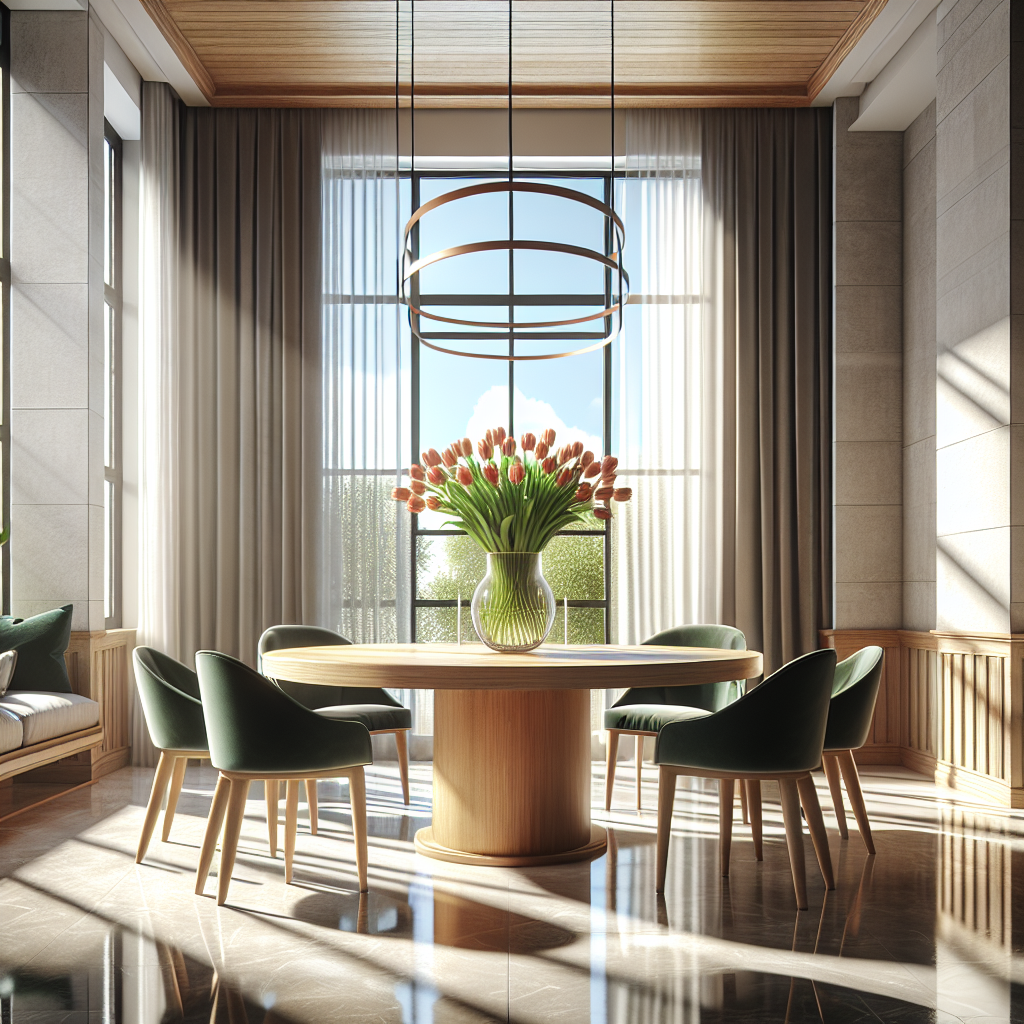Choosing the Right Material for Your Dining Table
Choosing the Right Material for Your Dining Table


Your dining table is more than just a piece of furniture; it's the focal point of shared meals, convivial gatherings, heartfelt conversations, and life's memorable celebrations. Choosing the right dining table material aligned with your space, preferences, and lifestyle plays a pivotal role in ensuring that these moments are enjoyed to the fullest. Today's market is buzzing with an array of materials, each bringing its unique charm and practicality. From the warm and sturdy realm of solid wood to the sleek sophistication of glass, the sheer variety can be both exciting and overwhelming.
So, how do you navigate through this multiplicity, zeroing in on the ideal material for your dining table? The key lies in understanding what each material offers concerning aesthetics, durability, upkeep, and budget. To help you make an informed decision, we delve into the particulars of some popularly chosen materials for dining tables: wood, metal, stone, glass, plastic, and tabletop. In this guide, we will focus on the importance of choosing a durable material for your dining table that will last a long time.
Wood Dining Tables
Creating an inviting, homely ambience in your dining room is effortless with a wooden dining table. Known for their durability and warm aesthetic, hardwood dining tables offer longevity compared to their softwood alternatives. These tables infuse a classic touch to any decor and are available in a variety of wood types, such as solid oak, maple, walnut, cherry, and mahogany. Let's delve deeper into the features of different types of wooden dining tables: solid wood, veneered MDF, and plywood.
Solid Wood
Solid oak dining tables and those crafted from hardwoods like walnut, teak, or softwood like pine, reign supreme when it comes to craftsmanship and longevity. Their robustness, combined with a unique grain pattern, adds an unmatched depth and character to your dining area.
● Unrivalled Durability: Solid wood tables are exceptionally durable and can withstand the test of time with proper care, making them an ideal choice for households with children or large gatherings.
● The versatility of designs: This material renders itself beautifully to various styles, right from rustic farmhouses to sleek contemporary designs. The natural variance in wood grain makes each table distinct, giving you a piece that is truly one-of-a-kind.
● Sustainability: Solid wood is a renewable and biodegradable resource, making it a sustainable choice for the environmentally conscious buyer.
● Scope for Restoration: Over time, if scratches and dents surface, most solid wood tables can be sanded and refinished, restoring their original beauty.
Veneered MDF
Veneered MDF (Medium Density Fibreboard) dining tables offer a great alternative to solid wood, combining durability with a handsome finish at a more affordable price point. These tables consist of an MDF core covered with a thin layer of real wood known as a veneer.
| MDF with Veneer Advantages | MDF with Veneer Limitations |
| Affordability: Less expensive than solid wood. | Durability: Not as durable as solid wood, particularly vulnerable to heat and humidity. |
| Uniform Finish: Offers a more consistent grain pattern and colour. | Refinishing: Difficult to refinish due to the thin veneer layer. |
| Stability: Less likely to warp or split compared to solid wood. | Repair: Damages can be harder to repair than solid wood. |
Plywood
Another alternative, plywood dining tables, brings lightness and durability in an economical package. Made from several thin layers of wood glued together, plywood exhibits impressive structural stability, making it less prone to cracking or warping. It's robust enough to stand up to daily use, and its layered edges can create a visually interesting contrast. However, while it's cheaper than solid wood or high-quality veneers, it may lack the aesthetic richness and depth that comes with solid wood grain.
Metal Dining Tables
Inserting a contemporary edge into your dining space becomes effortless with metal dining tables. Celebrated for their industrial chic appeal, these tables thrive on strength, durability, and easy maintenance. The different types of metal used bring about varied aesthetics and functionalities, making them a great choice for those looking for a durable table with a wide range of styles. Let's take a closer look at stainless steel, wrought iron, and aluminium dining tables.
Stainless Steel
Stainless steel dining tables are a favoured choice for those preferring a modern, minimalist look. Ranging from a high-gloss to a brushed finish, these tables are suitable for both indoor and outdoor use.
● Durability & Strength: Stainless steel is recognised for its excellent strength-to-weight ratio and resistance to corrosion, scratches, and heat.
● Maintenance: Stainless steel tables are easy to clean and maintain, making them an ideal option for bustling households.
● Aesthetic Versatility: Depending on the finish, they can blend seamlessly into a range of decor styles - from industrial chic to sleek modern designs.
● Outdoor Usage: Thanks to their weather-resistant qualities, stainless steel tables are a great choice for outdoor dining spaces.
Wrought Iron
Wrought iron dining tables offer a vintage charm mated with remarkable sturdiness. Primarily preferred for exteriors, they also lend a rustic appeal indoors. The intricate patterns possible with wrought iron bring out its unique artistic character. However, protection from rusting in moisture-prone environments is necessary for maintaining its longevity.
Aluminium
Seen in traditionally designed or avant-garde dining tables, Aluminium offers a corrosion-resistant, lightweight, and sturdy alternative to steel. Suitable for both indoor and outdoor use, aluminium tables bring a contemporary and industrial appeal owing to their silvery metallic finish.
Stone Dining Tables
Grace, sophistication, and timelessness exude from stone dining tables. Deemed lavish for their heavy weight and captivating stone veins and textures, these tables are excellent as statement pieces. Different types of stone, such as Marble, Granite, and Quartz, bring unique attributes and aesthetics to this highly coveted category of dining tables. Natural stone, in particular, offers a sturdy and durable option for dining tables, providing outstanding resistance to scratches and abrasions from daily use. For those on a budget, quartz is the most affordable option for a quality stone dining table.
Marble
Marble dining tables symbolise luxury at its finest. Their exquisite patterns and opulent aura make for irresistible centrepieces, transforming your dining space into an elegant sanctuary.
● Luxurious Appeal: A marble tabletop lends an air of sophistication and unmatched grandeur to your dining space.
● Unique Patterns: The natural veins and flecks present in marble are distinct to each slab, guaranteeing a one-of-a-kind piece.
● Durability: While marble requires careful maintenance to prevent staining, it can last for generations with proper care.
● Variety of Tones: Available in a range of natural hues, marble can complement an array of colour schemes.
Granite
If you are seeking the elegance of stone with exceptional resistance to wear and tear, Granite dining tables are your answer. These tables bring a unique charm to your dining area, their speckled surface adding to their visual depth.
| Granite Advantages | Granite Limitations |
| Durability: Extremely hard wearing and resistant to scratches. | Heavy Weight: Granite is extremely heavy, making it difficult to relocate. |
| Resistant: Resistant to heat damage. | Sealing Required: Needs periodic sealing to prevent surface staining. |
| Unique Patterns: Each granite slab boasts one-of-a-kind patterns and speckles. | Cost: Granite is a premium material and can be expensive. |
Quartz
Crafted from one of the hardest minerals on earth, Quartz dining tables rank high in durability and low in maintenance. Offering the allure of stone but sans the care required by Marble or Granite, these engineered stone tables are a popular choice in contemporary homes.
Glass Dining Table
For a dining table that exudes modern appeal and lends your space a sense of openness, consider a glass dining table. Glass is a great material to consider if you’re lacking on space and don’t want a room to feel overwhelmed with large heavy furniture. Because you can see through glass, you create the illusion of space as the eye can see further. Glass dining tables can make small spaces feel larger due to their transparent tops. Although they require frequent cleaning to keep smudges at bay, their ability to blend with any decor style makes them a versatile choice. While spacious, statement-making tables often come in rectangular or oval shapes, round glass tables are perfect for creating a cosy dining nook.
Plastic Dining Tables
For those desiring functionality over form, plastic dining tables are worth considering. Lightweight, economical, and exceptionally easy to clean, these tables make an ideal pick for homes with young children or outdoor areas. Among plastic tables, PVC and Polypropylene variants are commonly available options.
PVC
PVC, also known as Vinyl, is lauded for its versatility and endurance. Resistant to water and flame, PVC dining tables can withstand the rigours of outdoor elements.
● Water and Flame Resistant: PVC tables are an excellent choice for outdoor use owing to their ability to resist water and flame.
● Durability: These tables exhibit a good degree of robustness, capable of withstanding reasonable levels of wear and tear.
● Low Maintenance: PVC tables can be cleaned easily with mild soapy water.
● Affordability: Available at lower price points, PVC dining tables provide a cost-effective solution for your dining needs.
Polypropylene
Offering a balance of aesthetics and functionality, Polypropylene (PP) dining tables are another practical option within the realm of plastic tables. Famed for their ruggedness, chemical resistance, and ability to mimic other materials like wood and wicker, PP tables guarantee high permutation in design, colour, and texture.
